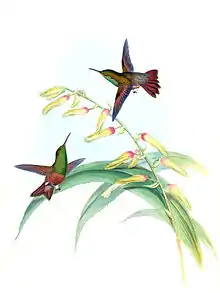Chestnut-bellied hummingbird
The chestnut-bellied hummingbird (Saucerottia castaneiventris) is a species of hummingbird in the family Trochilidae. It is found only in Colombia. Its natural habitats are subtropical or tropical moist montane forest and subtropical or tropical high-altitude shrubland. It is threatened by habitat loss.
| Chestnut-bellied hummingbird | |
|---|---|
 | |
| Scientific classification | |
| Kingdom: | Animalia |
| Phylum: | Chordata |
| Class: | Aves |
| Order: | Apodiformes |
| Family: | Trochilidae |
| Genus: | Saucerottia |
| Species: | S. castaneiventris |
| Binomial name | |
| Saucerottia castaneiventris (Gould, 1856) | |
Taxonomy
This species was formerly placed in the genus Amazilia. A molecular phylogenetic study published in 2014 found that the genus Amazilia was polyphyletic.[2] In the revised classification to create monophyletic genera, the chestnut-bellied hummingbird was moved to the resurrected genus Saucerottia.[3][4]
Description
The chestnut-bellied hummingbird is small (8.4 cm) with reddish-brown underparts and tail. It has a grey rump and shining green throat and chest. Its legs are small and white while it has a black bill and pinkish base to lower mandible.
Distribution and habitat
The chestnut-bellied hummingbird distribution appears to be restricted to the dryer parts of the Magdalena Valley, Colombia, with a core known range in the Chicamocha, Suárez and Chucurí river valleys. Even though there are now sites where it is known to be found, it is unpredictable in occurrence because of the unknown seasonal fluctuations. It spends the core of its range in dry valleys. Recent records have found it in more humid areas such as the Chucurí near San Vicente de Chucurí and La Paz. Otherwise it has been found in Tipacoque, and a sighting in 2006 at Soatá and has been recorded in five municipalities including a rediscovered population in the environs of Soatá. The sightings seem to be around the range of 850 to 2,200 metres (2,790 to 7,220 ft) above sea level because they like to habituate in places which are usually dry, but due to its current relocating it can now also be found in humid environments as well.
Status and threats
The population is estimated at 3,780 individuals, by extrapolating its known territory size by the area of suitable habitats. However, since many suitable habitats aren't occupied by these and they are not evenly distributed, this may represent an overestimate.[5][6]
The chestnut-bellied hummingbird is located in the dense population region of Colombia. In the past twenty or so years, there has been expansive economic growth, due to a gold rush in 1996 and also the increasingly profitable business of deforestation. Not only are the forests being cut down, but also sugar and coffee plantations are replacing them. Decreased habitats and increased pollution and human migration accompanied these new industries. Although these businesses are benefitting the Colombian economy, they are by far the largest threats to the habitat of the endangered bird.[6][7]
.jpg.webp)
References
- BirdLife International (2019). "Amazilia castaneiventris". IUCN Red List of Threatened Species. 2019. Retrieved 10 December 2019.CS1 maint: ref=harv (link)
- McGuire, J.; Witt, C.; Remsen, J.V.; Corl, A.; Rabosky, D.; Altshuler, D.; Dudley, R. (2014). "Molecular phylogenetics and the diversification of hummingbirds". Current Biology. 24 (8): 910–916. doi:10.1016/j.cub.2014.03.016.
- Stiles, F.G.; Remsen, J.V. Jr.; Mcguire, J.A. (2017). "The generic classification of the Trochilini (Aves: Trochilidae): Reconciling taxonomy with phylogeny". Zootaxa. 4353 (3): 401–424. doi:10.11646/zootaxa.4353.3.
- Gill, Frank; Donsker, David; Rasmussen, Pamela, eds. (July 2020). "Hummingbirds". IOC World Bird List Version 10.2. International Ornithologists' Union. Retrieved 8 January 2020.
- Encyclopedia of Life Amazilia castaneiventris: details.
- Chestnut-bellied Hummingbird." N.p., n.d. Web. 25 Oct. 2012. Chestnut-bellied Hummingbird / Amazilia castaneiventris.
- "Chestnut-bellied Hummingbird." N.p., n.d. Web. 25 Oct. 2012. Chestnut-bellied hummingbird (Amazilia castaneiventris) Archived 2011-12-17 at the Wayback Machine.
- Cortes-Herrera, O., A. Hernandez-Jaramillo, and E. Briceno-Buitrago. "Rediscovery of the Chestnut-bellied Hummingbird, an Endangered Endemic from Colombia." Web of Science. Springer, Aug. 2006. Web. 24 Oct. 2013.
- BirdLife International (2013) Species factsheet: Amazilia castaneiventris. Downloaded https://www.webcitation.org/5QE8rvIqH?url=http://www.birdlife.org/ on 25/10/2013. Recommended citation for factsheets for more than one species: BirdLife International (2013) IUCN Red List for birds.
- "Chestnut-bellied Hummingbird (Amazilia Castaneiventris)." Chestnut-bellied Hummingbird Videos, Photos and Facts. N.p., n.d. Web. 24 Oct. 2013.
- "Xeno-canto." Chestnut-bellied Hummingbird (Amazilia Castaneiventris) ::. N.p., n.d. Web. 24 Oct. 2013.

